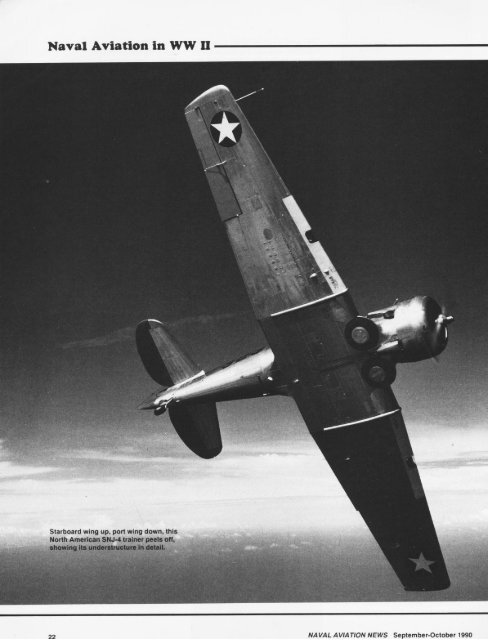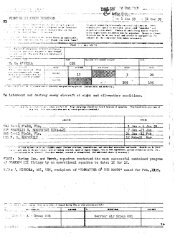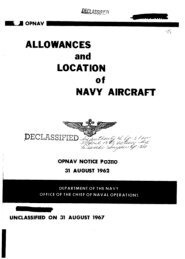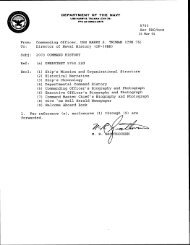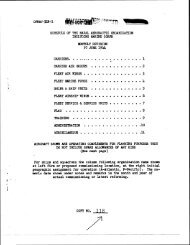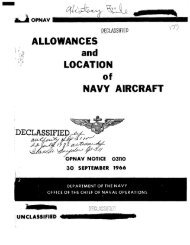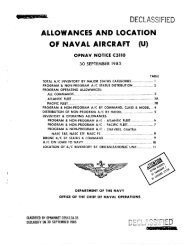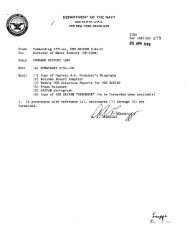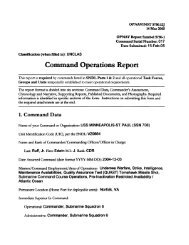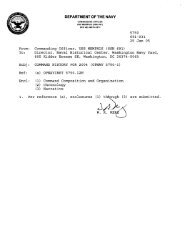Aviation Training and Expansion, Part 2 - Naval History and ...
Aviation Training and Expansion, Part 2 - Naval History and ...
Aviation Training and Expansion, Part 2 - Naval History and ...
Create successful ePaper yourself
Turn your PDF publications into a flip-book with our unique Google optimized e-Paper software.
Starboard wing up, port wing down, this<br />
North American SNJ-4 trainer peels off,<br />
showing its understructure in detail.<br />
22 NAVAL AVIATION NEWS September-October 1990
<strong>Aviation</strong><br />
<strong>Training</strong><br />
<strong>and</strong><br />
<strong>Expansion</strong> .<br />
.<br />
<strong>Part</strong> 2<br />
By Capt. Matt Portz, USNR(Ret.)<br />
This is the second of a two-part<br />
sto y by retired Captain Matt Portz,<br />
which reviews the Navy’s pilot training<br />
within the context of the wartime<br />
<strong>and</strong> national events as seen through<br />
the eyes of some who lived at the time.<br />
Capt. Portz served in a destroyer<br />
before entering j-ligh t training <strong>and</strong><br />
then was a Prima y <strong>and</strong> instrument<br />
flight instructor. He is currently vice<br />
president of A via tion Consultants,<br />
Inc., of Los Angeles, Califi<br />
T<br />
he pilot training program was<br />
changed again in January<br />
1943. Flight preparatory<br />
schools were opened at 20 colleges<br />
<strong>and</strong> universities where cadets began<br />
their training with three months of<br />
academic work, <strong>and</strong> then went on for<br />
two months of elementary flight <strong>and</strong><br />
ground instruction under civilians at<br />
War <strong>Training</strong> Service (WTS) schools,<br />
as the Civil Aeronautics Authority<br />
(CAA) Civilian Pilot <strong>Training</strong> Program<br />
had been renamed. They continued<br />
on at the preflight schools for three<br />
months <strong>and</strong> then on to Primary. The<br />
Great Lakes steamer Wolverine had<br />
been commissioned the previous<br />
August, <strong>and</strong> sister ship Sable in May<br />
1943, to provide flight decks in submarine-free<br />
Lake Michigan for carrier<br />
training of pilots <strong>and</strong> deck crews. By<br />
now, <strong>Naval</strong> <strong>Aviation</strong> had more than<br />
17,000 aircraft, 26,600 pilots, 23,300<br />
nonpilot officers, <strong>and</strong> 156,000 enlisted<br />
personnel.<br />
On other war fronts, new Essexclass<br />
carriers were seeing action in<br />
1943, <strong>and</strong> the Grumman F6F Hellcat<br />
entered combat. The Germans had<br />
surrendered at Stalingrad, two attempts<br />
by German officers to kill Hitler<br />
failed, Japanese resistance ended on<br />
Guadalcanal, <strong>and</strong> Admiral Yamamoto<br />
was shot down. Italy was invaded by<br />
the Allies <strong>and</strong> the Italians surrendered<br />
<strong>and</strong> declared war on their erstwhile<br />
Axis partners. Roosevelt, Churchill,<br />
<strong>and</strong> Stalin met at Tehran <strong>and</strong> agreed<br />
that the invasion of France would get<br />
first American <strong>and</strong> British priority.<br />
At the end of 1943, the <strong>Naval</strong> Air<br />
NAVAL AVIATION NEWS Scntemhnr-Cktnher 1QQfl<br />
71
<strong>Training</strong> Comm<strong>and</strong>, under the Chief of heavier <strong>and</strong> more powerful operational<br />
<strong>Naval</strong> Operations, was established<br />
aircraft. After learning to h<strong>and</strong>le an<br />
with headquarters at Pensacola, Fla., airplane in Primary, he moved to 14 to<br />
to direct all <strong>Naval</strong> <strong>Aviation</strong> training of 18 weeks <strong>and</strong> 160 more flight hours in<br />
the Primary, Intermediate, <strong>and</strong> Opera- Intermediate at Pensacola or Corpus<br />
tional air training comm<strong>and</strong>s. At this Christi, Texas. Time in higher horsepoint<br />
in the war, naval aviation cadets power trainers <strong>and</strong> instrument flight<br />
had completed almost a year of train- came before he specialized in carrier,<br />
ing before reaching Primary. During multiengine sea or l<strong>and</strong>, or observathe<br />
first four months, a prospective<br />
tion-type aircraft designated, respeccadet,<br />
as a seaman “tarmac,” did ap- tively, CV, VPB or VB2, or VOIVCS.<br />
prentice chores at an air station,<br />
Intermediate trainers were the Vulr<br />
theoretically, to bind him emotionally tee SNV Valiant (commonly called<br />
to <strong>Naval</strong> <strong>Aviation</strong> <strong>and</strong>, practically, to “Vibrator”), North American SNJ<br />
make him unavailable for the draft. Texan, Consolidated PBY Catalina,<br />
Gaining cadet status, he moved to a Beech SNB Kansan, <strong>and</strong> Vought<br />
flight preparatory school at one of 17 OS2U Kingfisher. Prior to graduation<br />
(formerly 20) colleges for three months <strong>and</strong> commissioning, students selected<br />
of military indoctrination, physical train- as carrier pilots flew the SNJ while<br />
ing, mathematics, physics, basic<br />
specializing in tactics for fighters, VF;<br />
navigation, <strong>and</strong> aircraft <strong>and</strong> ship recog- torpedo-bombers, VTB; or scout/divenition.<br />
Next came 8 to 12 weeks at<br />
one of the now 92 colleges <strong>and</strong> civilian<br />
flight operators with CAA-WTS<br />
schools, which gave him 35 to 40<br />
bombers, VSB. Assignment of new<br />
hours of flight instruction in light * *<br />
aircraft. Most of the inept were<br />
eliminated here; the rest were exposed<br />
to three months of physical<br />
training at the North Carolina, Iowa,<br />
Georgia, or California preflight schools.<br />
Now came 11 to 14 weeks <strong>and</strong> 90<br />
to 100 flight hours of Primary, usually<br />
in a t3oeing N2S “Stearman,” officially<br />
the Kaydet. Precision flight was drilled<br />
into him for the necessary transition to<br />
pilots to type squadron was based on<br />
“needs of the service” as well as his<br />
preference, with far more weight on<br />
the former.<br />
Following Intermediate were two<br />
months of Operational training at one<br />
of 17 naval air stations along the<br />
Florida, Georgia, <strong>and</strong> Carolina coasts<br />
to give new <strong>Naval</strong> Aviators a loo-hour<br />
taste of combat-type aircraft as<br />
weapons. Among operational aircraft<br />
were the Grumman F4F, or General<br />
Motors FM-2, Wildcat; Grumman F6F<br />
Hellcat; Vought F4U, or Goodyear FG,<br />
Corsair; Douglas SBD Dauntless;<br />
Grumman TBF, or General Motors<br />
TBM, Avenger; Curtiss SB2C<br />
He//diver; Lockheed PV Ventura; Consolidated<br />
PBY Catalina; <strong>and</strong> Martin<br />
PBM Mariner. Those destined for carrier<br />
assignment qualified aboard Wolverine<br />
or Sable, although a few used<br />
Shots from 1944: right, Link trainers at<br />
NAS Livermore, Calif.; below, SNV-1,<br />
NAS Livermore; <strong>and</strong> below right, Howard<br />
NH-1 instrument trainer.
NAVAL AVIATION NEWS September-October 1990<br />
the escort carrier Charger in the Norfolk,<br />
Va., area. From here, it was on to<br />
a squadron where training was always<br />
a constant.<br />
An unforgivable sin in Navy flying<br />
then (<strong>and</strong> now) was “flathatting.” Lowaltitude<br />
buzzing over a girlfriend’s<br />
house or exuberant low passes down<br />
a highway were bad news. Hot pilots<br />
liked to be seen <strong>and</strong> thought themselves<br />
appreciated by the populace.<br />
Those stupid enough to make a<br />
secopd pass frequently wound up on<br />
report. Those with no luck at all became<br />
fatalities after encounters with<br />
unseen wires, trees, <strong>and</strong> ends of box<br />
canyons.<br />
In an attempt to control flathatting,<br />
some air stations placed stories in<br />
newspapers asking citizens to report<br />
the time, place, <strong>and</strong> number of any<br />
sighting where the plane’s large identification<br />
numbers could be read.<br />
While this system may not have<br />
eliminated sinning, it definitely<br />
generated fewer second passes.<br />
Vineyards covered much of the l<strong>and</strong><br />
near one California base; sheep<br />
grazed on nearby hillsides where hot<br />
shots sometimes buzzed the animals.<br />
One jockey with a strange sense of<br />
humor forced a thous<strong>and</strong> men at<br />
another base to hit the deck during a<br />
Saturday morning inspection. A court<br />
martial gave this chap the rest of the<br />
war to contemplate his folly with a mop<br />
rather than an aircraft’s control in his<br />
h<strong>and</strong>s.<br />
Many farmers <strong>and</strong> ranchers accepted<br />
property damage by aircraft as<br />
a contribution to the war effort.<br />
Aviators not on an immediate flight<br />
schedule were sometimes detailed by<br />
the station’s legal department to pay a<br />
public relations visit to an injured<br />
party, who was asked to sign a conditional<br />
damage release. My destination<br />
on one such detail was to the Concannon<br />
Winery in the Livermore, Calif.,<br />
valley where a fatal crash had torn up<br />
rows of choice vines. The lane wound<br />
through the vine.yard to an old California-style<br />
house.<br />
, A servant answered my knock <strong>and</strong><br />
ushered me into the home’s cool interior.<br />
There I was received by a fatherly<br />
gentleman, Joseph Concannon, son of<br />
<strong>Naval</strong> <strong>Aviation</strong> in WW II<br />
the vineyard’s founder, who questioned<br />
me about my knowledge of<br />
wine. When told I knew nothing about<br />
it, he suggested that I might want to<br />
sample his product. Cheese, crackers,<br />
<strong>and</strong> several varieties of delicious white<br />
wine were brought out. While we<br />
sipped, the vintner explained about the<br />
varieties of grapes used in wine<br />
making. The grapes’ history <strong>and</strong> the<br />
manufacturing process were fascinating.<br />
So was the taste.<br />
Only when this pleasant activity<br />
came to a natural conclusion did Mr.<br />
Concannon ask, “Now, son, where is<br />
that paper you want me to sign? We<br />
lost a few vines. They can be<br />
replaced, but those two young men<br />
killed in that crash can never be.” I left<br />
with a signed document <strong>and</strong> warm feelings<br />
which last to this day for Mr. Concannon<br />
<strong>and</strong> his art.<br />
Information about the numbers of<br />
training accidents as compared to<br />
those in the fleet is unavailable.<br />
Probably there were more of the<br />
former. Overall Navy flight statistics for<br />
1945 are available <strong>and</strong> the numbers<br />
are impressive. That year, 15.5-million<br />
Cadets <strong>and</strong> instructors check the flight assignment board at NAS Livermore, 1944.
hours were flown. More than 13,000<br />
major accidents occurred; half resulted<br />
in destroyed aircraft. The more than<br />
3,000 fatalities were at the rate of 20.5<br />
per 100,000 hours flown. Current<br />
statistics show Navy flying as being<br />
much safer. In the 2,238,777 flight<br />
hours in 1989, there were 55 Class-A<br />
accidents (involving fatalities or<br />
damage of at least $1 million) with 54<br />
aircraft lost <strong>and</strong> 78 fatalities - a rate of<br />
only 2.46 per 100,000 hours.<br />
? Flight students lived in barracks,<br />
<strong>and</strong> by the rules, which read in part:<br />
“Cadets are to form details <strong>and</strong> return<br />
to barracks following noon chow. It is<br />
m<strong>and</strong>atory that cadets fall in details of<br />
four men or more. Cadets are required<br />
to attend all musters for meal formations.<br />
They must be in full uniform <strong>and</strong><br />
will be marched to the mess hall at all<br />
times. Caps off in cadet regiment.<br />
H<strong>and</strong>s out of pockets at all times.<br />
Cadets are urged to attend Divine Service<br />
held in the chapel each Sunday;<br />
0630 <strong>and</strong> 0830 Roman Catholic mass;<br />
1000 Protestant divine services.<br />
Cadets are required to have regulation<br />
haircuts. Cadets will use the barber<br />
shop supplied by Ship’s Service.”<br />
There were dozens of others.<br />
The otherwise well-disciplined life of<br />
flight students was interrupted occasionally<br />
by juvenile high jinks. One<br />
character followed a regular evening<br />
routine - a before-taps shower followed<br />
by a naked run through the barracks<br />
screaming the Tarzan call.<br />
Reaching his upper bunk, he’d swing<br />
from a h<strong>and</strong>y pipe into his sack.<br />
One evening during the shower<br />
phase, his barracks mates replaced<br />
the basic springs with light twine,<br />
warned the man in the bunk below,<br />
<strong>and</strong> waited. Right on schedule came<br />
the naked dash, the Tarzan yell, the<br />
swing into the sack ... <strong>and</strong> crash.<br />
Some pleasures were simple then.<br />
Women Apppointed for Volunteer<br />
Emergency Service, WAVES, served<br />
on most training bases in about every<br />
kind of nonflying job. They did their<br />
jobs as well as the men. WAVES also<br />
served on the “Stearman” flight line.<br />
That aircraft’s engine was started by<br />
cranking an inertia starter by a person<br />
st<strong>and</strong>ing on a wing from where the<br />
cranker’s posterior pointed directly at<br />
the instructor <strong>and</strong> student. This fact<br />
seldom went unnoticed when the<br />
cranker was female. Many romances<br />
were observed to blossom on the flight<br />
line.<br />
Starting procedure required the fuel<br />
valve to be on <strong>and</strong> the engine primed.<br />
When the cranker’s muscles got the<br />
starter to speed, crank h<strong>and</strong>le was<br />
removed, ignition thrown on, <strong>and</strong><br />
starter engaged. If the engine didn’t<br />
start immediately, the probable cause<br />
was a cockpit goof. Such trouble was<br />
minimized by the offending cadet<br />
cranking during the next start attempt.<br />
The Marshall Isl<strong>and</strong>s were occupied<br />
with support from six heavy <strong>and</strong> six<br />
light carriers in 1944. Carrier strikes<br />
against Japanese-held isl<strong>and</strong>s intensified,<br />
<strong>and</strong> Navy planners fixed total<br />
pilot output for 1944, 1945, <strong>and</strong> 1946<br />
as 20,000, 15,000, <strong>and</strong> 10,000. The<br />
Chief of <strong>Naval</strong> Operations issued<br />
plans to make drastic reductions in<br />
pilot training. Some students in<br />
preflight <strong>and</strong> earlier training stages<br />
were to be transferred to other duties.<br />
Enough were retained to maintain a<br />
preflight course exp<strong>and</strong>ed to 25<br />
weeks. So called “deselection” <strong>and</strong><br />
voluntary withdrawal from flight training<br />
began in June, the month of the<br />
Norm<strong>and</strong>y l<strong>and</strong>ings in Europe <strong>and</strong> the<br />
beginning of the Mariana Isl<strong>and</strong>s campaign<br />
in the Pacific. These reductions<br />
brought an end to the CAA-WTS <strong>and</strong><br />
flight preparatory school phases of<br />
pilot training, <strong>and</strong> release of a number<br />
of training.stations in September.<br />
Before these changes began, the<br />
<strong>Naval</strong> Air Primary <strong>Training</strong> Comm<strong>and</strong><br />
consisted of <strong>Naval</strong> Air Stations (NASs)<br />
at Bunker Hill, Ind.; Dallas, Texas;<br />
Glenview, III.; Grosse Ile, Mich.;<br />
Hutchinson’<strong>and</strong> Olathe, Kans.; Livermore,<br />
Calif.; Memphis, Tenn.; Minneapolis,<br />
Minn.; New Orleans, La. (instructors<br />
school); Norman, Okla.; Ottumwa,<br />
Iowa; <strong>and</strong> St. Louis, MO. Total<br />
aircraft numbered almost 3,600 <strong>and</strong><br />
personnel, including students, 46,700.<br />
At the same time, the <strong>Naval</strong> Air Intermediate<br />
Comm<strong>and</strong> included the<br />
<strong>Naval</strong> Air <strong>Training</strong> Centers at Pensacola<br />
<strong>and</strong> Corpus Christi; as well as<br />
the instrument instructors school at<br />
NAS Atlanta, Ga. The Pensacola cen-<br />
Marching cadets at NAS<br />
Livermore in 1944.<br />
ter included <strong>Naval</strong> Auxiliary Air Stations<br />
(NAASs), Barin, Bronson, Corry,<br />
Ellyson, Saufley, <strong>and</strong> Whiting fields.<br />
The center at Corpus Christi consisted<br />
of NAASs Cabaniss, Chase, Cuddihy,<br />
Kingsville, Rodd, <strong>and</strong> Waldron fields.<br />
Comm<strong>and</strong> aircraft numbered 4,200<br />
<strong>and</strong> personnel, including students, almost<br />
73,000.<br />
The <strong>Naval</strong> Air Operational <strong>Training</strong><br />
Comm<strong>and</strong> in March 1944 comprised<br />
NASs Banana River, Daytona Beach,<br />
Del<strong>and</strong> <strong>and</strong> Fort Lauderdale, Fla., <strong>and</strong><br />
Beaufort, S.C.; NAAS Cecil Field, Fla.;<br />
Marine Corps Air Station, Edenton,<br />
N.C.; <strong>and</strong> the carrier qualification unit<br />
at NAS Glenview, III. Also in the comm<strong>and</strong>:<br />
NAAS Green Cove Springs,<br />
Fla.; NASs Jacksonville, Melbourne,<br />
Miami, Sanford <strong>and</strong> Vero Beach, Fla.;<br />
<strong>and</strong> St. Simons Isl<strong>and</strong>, Ga. (radar<br />
school). Other stations were the<br />
<strong>Naval</strong> Air Navigation School,<br />
26<br />
NAVAL AVIATION NEWS September-October 1990
NAVAL AVIATION NEWS Sedember-October 1990 27<br />
Author Matt Portz, then a Ltjg., posing<br />
with a Waco UPF-7, Lockport, Ill., 1943.<br />
Shawnee, Okla. <strong>and</strong> NAAS Mayport,<br />
Fla. Comm<strong>and</strong> aircraft numbered<br />
more than 2,900, personnel almost<br />
54,500.<br />
More than 48,000 pilots were on<br />
<strong>Naval</strong> <strong>Aviation</strong> roles in 1944, as well<br />
as 31,000 nonpilot officers <strong>and</strong><br />
275,000 enlisted personnel.<br />
Reassignment of missions of a number<br />
of training bases in 1944 should<br />
have signaled that the need for pilots<br />
was winding down. Those of us instructing<br />
in the system didn’t read the<br />
signs. Perhaps we could be excused:<br />
fighting in Europe <strong>and</strong> in the Pacific<br />
was at its bloodiest. Japanese resistance<br />
on Iwo Jima was crushed by the<br />
Marines in March 1945; American<br />
fighter planes flew from airfields in<br />
Japan’s front yard; our high-speed carrier<br />
task forces operated at will; the<br />
Philippines were in our h<strong>and</strong>s; Boeing<br />
B-29 Super-fortresses were incinerating<br />
Japanese cities; <strong>and</strong> the invasion<br />
of Okinawa had begun. In Europe,<br />
U.S. Army troops crossed the Rhine at<br />
Remagen into Hitler’s disintegrating<br />
Third Reich. <strong>Naval</strong> <strong>Aviation</strong> now num-<br />
bered 41,000 aircraft, 60,000 pilots,<br />
33,000 nonpilot officers, <strong>and</strong> almost<br />
338,000 enlisted personnel.<br />
Attrition among Navy flight students<br />
had been increasing by plan for a<br />
year. With the end of the war in sight,<br />
cadet washout rates climbed. Granting<br />
of extra instructional time to those who<br />
flew down-checks was severely<br />
restricted. Extra instruction to smooth<br />
out flight deficiencies had been<br />
routine. No more; things had changed<br />
drastically. Many who earlier would<br />
have made it, did not. Flight or ground<br />
school, psychological or medical unfitness,<br />
or any of a dozen reasons<br />
caused washouts.<br />
Before the axe fell on the hapless,<br />
his record was reviewed by a board of<br />
ranking officers whose recommendations<br />
were usually approved. Those<br />
eliminated, depending on the<br />
individual’s back.ground, went to officer<br />
or aircrew training. The few who had<br />
held ratings or rank before becoming<br />
cadets normally returned to their<br />
former status.<br />
Events continued to overtake flight<br />
instructors like me. In early May, the<br />
base shifted to a work schedule of 6<br />
days on with Sundays off, rather than<br />
the more strenuous 10 days working<br />
<strong>and</strong> 2 days off. On May 7, 1945, the<br />
Germans surrendered to General<br />
Eisenhower at Rheims. V-E Day was<br />
observed the following morning by the<br />
executive officer reading us an expression<br />
of gratitude from our national<br />
leaders for victory, <strong>and</strong> of the determination<br />
to quickly defeat the<br />
Japanese in the Pacific. I flew as<br />
usual with cadets that day, but within a<br />
week had orders to a “refresher”<br />
course to prepare for return to the<br />
fleet. The “refresher” turned out to be<br />
a holding pattern until it was clear<br />
whether those like me would be<br />
needed against Japan. Replacement<br />
pilots on hold were experienced,<br />
young, <strong>and</strong> eager.<br />
Not until years later when top secret<br />
war plans were declassified was the<br />
holding pattern understood. The Joint<br />
Chiefs of Staff had plans for the invasion<br />
of Kuyushu on the first of<br />
November 1945, <strong>and</strong> four months later<br />
the Tokyo Plain. Some 2,700 ships,<br />
more than 100 of them carriers, would<br />
participate.<br />
By now, most realized the war was<br />
nearing an end. Hiroshima was<br />
atomized by the bomb on August 6,<br />
1945, dropped from the B-29 “Enola<br />
Gay,” flown by the same Colonel Paul<br />
Tibbets with whom I had hitched a ride<br />
in 1944 when returning from instrument<br />
instructors school at Atlanta. The<br />
bomb hit Nagasaki August 9, most<br />
hostilities ceased August 14, <strong>and</strong> the<br />
surrender was signed aboard Missouri<br />
September 2.<br />
World War II had ended.<br />
Demobilization was rapid. Within a few<br />
months, most <strong>Naval</strong> Aviators went<br />
home to civilian life, some stayed in<br />
the Navy, <strong>and</strong> many went into the<br />
<strong>Naval</strong> Air Reserve. During the war in<br />
Korea that came in five years, fleet carrier<br />
air groups, by June 1951, found<br />
that every third air strike against the<br />
Communists was flown by a reservist.<br />
Princeton, Boxer, <strong>and</strong> Bon Homme<br />
Richard were in action with air groups<br />
of 50, 90, <strong>and</strong> loo-percent reservists.<br />
But that is another story. This one<br />
ends here. n<br />
October 5: The Secretary of the<br />
Navy placed all divisions <strong>and</strong> aviation<br />
squadrons of the Organized Reserve<br />
on short notice for call to active duty<br />
<strong>and</strong> granted authority to call Fleet<br />
Reservists as necessary. On the 24th<br />
the Bureau of Navigation announced<br />
plans for mobilizing the aviation<br />
squadrons, which called for one-third<br />
to be ordered to active duty by 7<br />
November <strong>and</strong> all by 1 January 1941.<br />
October 23: Within the Atlantic<br />
Squadron, an administrative comm<strong>and</strong><br />
was set up for carrier aviation entitled,<br />
“Aircraft, Atlantic Squadron.”<br />
October 24: An administrative comm<strong>and</strong><br />
for patrol aviation in the Atlantic<br />
Squadron was set up under the title,<br />
“Patrol Wings, Atlantic Squadron.”<br />
October 28: The Chief of <strong>Naval</strong><br />
Operations reported that aircraft with<br />
some form of armor <strong>and</strong> fuel protection<br />
were just beginning to go into service<br />
use, <strong>and</strong> that within a year all fleet<br />
aircraft, except those assigned Patrol<br />
Wing 2, would have such protection.<br />
Next issue: Technical<br />
ment before the war<br />
develop-


